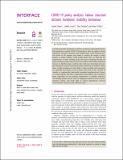| dc.contributor.author | Heroy, Samuel | |
| dc.contributor.author | Loaiza, Isabella | |
| dc.contributor.author | Pentland, Alex | |
| dc.contributor.author | O’Clery, Neave | |
| dc.date.accessioned | 2021-04-05T15:04:55Z | |
| dc.date.available | 2021-04-05T15:04:55Z | |
| dc.date.issued | 2021-03-31 | |
| dc.identifier.uri | https://hdl.handle.net/1721.1/130362 | |
| dc.description.abstract | Countries and cities around the world have resorted to unprecedented mobility restrictions to combat COVID-19 transmission. Here we exploit a natural experiment whereby Colombian cities implemented varied lockdown policies based on ID number and gender to analyse the impact of these policies on urban mobility. Using mobile phone data, we find that the restrictiveness of cities’ mobility quotas (the share of residents allowed out daily according to policy advice) does not correlate with mobility reduction. Instead, we find that larger, wealthier cities with more formalized and complex industrial structure experienced greater reductions in mobility. Within cities, wealthier residents are more likely to reduce mobility, and commuters are especially more likely to stay at home when their work is located in wealthy or commercially/industrially formalized neighbourhoods. Hence, our results indicate that cities’ employment characteristics and work-from-home capabilities are the primary determinants of mobility reduction. This finding underscores the need for mitigations aimed at lower income/informal workers, and sheds light on critical dependencies between socio-economic classes in Latin American cities. | en_US |
| dc.language.iso | en | en_US |
| dc.publisher | Journal of the Royal Society Interface | en_US |
| dc.rights | Attribution-NonCommercial-ShareAlike 3.0 United States | * |
| dc.rights.uri | http://creativecommons.org/licenses/by-nc-sa/3.0/us/ | * |
| dc.title | COVID-19 policy analysis: labour structure dictates lockdown mobility behaviour | en_US |
| dc.type | Article | en_US |
| dc.identifier.citation | Heroy, S., Loaiza, I., Pentland, A., & O’Clery, N. (2021). COVID-19 policy analysis: labour structure dictates lockdown mobility behaviour. Journal of the Royal Society Interface, 18(176), 20201035. | en_US |
| dc.contributor.department | MIT Connection Science (Research institute) | |
